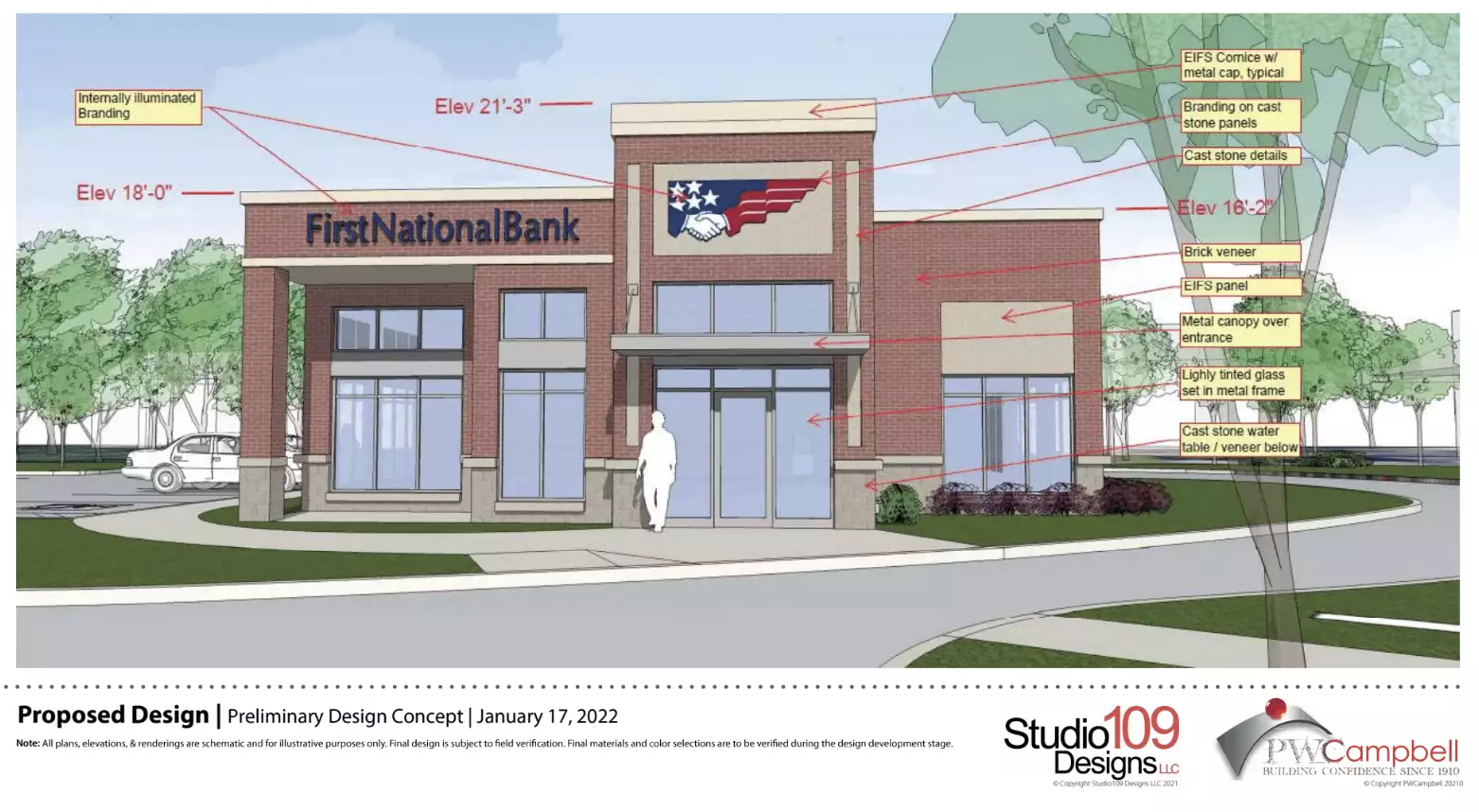Last Tuesday, the Mt Lebanon Commission approved the plans for the development of a new FNB Bank to be placed at the location of the existing (and empty) Dollar General store on Cochran Road. I thought it would be a good time to further discuss the development process, this time from the standpoint of our SALDO.
What is the SALDO?
SALDO stands for Subdivision and Land Development Ordinance, which are the rules and regulations that makeup how the land can be subdivided and developed within the municipality. The SALDO goes hand-in-hand with our Zoning code and building code, which, together make up all the rules and regulations that govern property development, redevelopment, land usage, and the rules on how buildings can be constructed.
The Zoning code determines what TYPE of property can be developed or built in any specific area. For example, C-1 is a commercial zone that allows commercial buildings, office space, and other business types. R-1 is single-family residential. R-2 allows multifamily properties, but only of relatively low density. Inside each section of the zoning code, you will find information that further defines the rules and regulations of what can be done in any zone, like whether fences or pools might be allowed, the types of and widths of roads and driveways that are required, etc. The Zoning code is a very versatile document and usually the first stop for any property developer looking to build in Mt Lebanon.
After a developer consults the Zoning code to see if a specific building type is possible on a particular parcel, they consult the SALDO which sets out design standards and gives developers further information about how that property can be developed and the procedure for turning in documents for the development. For example, the SALDO sets forth rules for Stormwater Conveyance and Management, Sanitary Sewers, Handicapped Accessibility, Landscaping and Screening Standards, Pervious Pavement, and other items. The SALDO sets construction hours between 7:00 am and 7:00 pm Monday through Saturday, all day Sunday and on federally designated holidays. It also sets the required turning radius for cul-de-sacs to allow for emergency vehicles to navigate them properly, and where sidewalks should be provided, if at all.
The Development Process
We discuss the overall real estate development process in depth in another article, but the general process goes like this:
Present Plans to develop a property
The Planning Commission reviews the submission to make sure that plan follows the zoning code and SALDO. If there are elements of the plan that do not fit the zoning code, the developer can appeal to the Zoning Hearing Board and ask for a variance. If there are elements of the plan that do not fit the SALDO they can ask for a waiver from the Commission.
There are only 5 reasons to approve a variance, and since this is a quasi-judicial board, those 5 reasons are legal thresholds that must be met. This is the reason so few variances are granted. If the developer (or resident) doesn’t like the decision of the Zoning Hearing Board they can appeal that decision to the Court of Common Pleas in Allegheny County. There have been several appeals of our ZHB decisions in the past 6 years. None of them have succeeded at the county level.
A developer can ask for a waiver from any of the requirements of the SALDO, and these are reviewed directly by the Commission. And this is where my story picks back up.
SALDO WAIVERS
Waivers are not usually requested for single-family developments or smaller commercial properties – because they can be easily developed within the rules of the SALDO. When developers attempt to fit too much on a lot, or save a few dollars on items we require but other neighborhoods don’t, the Commission might see more waiver requests. And that’s what happened with the FNB recently approved.
Section 704 of the SALDO sets forth rules about sidewalks. Section 704.1 simply states:
In all subdivisions and land developments, sidewalks shall be installed along the portions of the property abutting a street.
Section 704.1. Mt Lebanon SALDO
That means when someone proposes a new development or redevelops an existing property, if they abut a street (public, private, or otherwise designated) a sidewalk, if it does not already exist, must be installed.
Being a “walking community” you can imagine why this portion of our SALDO is extremely important. Yet sidewalk requirements are not implemented consistently and their application has varied from commission to commission. That’s why we see some roads have them and some roads don’t.
FNB Requests Sidewalk Waiver
During the development process, the developers of the new proposed FNB requested a sidewalk waiver for the street abutting their property — the northern property boundary with Ferren Alley. The developers claimed, among other things, that the land coming off the alley was too shallow and too steep such that following the SALDO would cause the developer to expend additional funds to install a sidewalk. To install a sidewalk, they would have likely had to ease the slope coming off the alley, which in turn would have likely required ground fill and potentially a stabilizing wall.
However, the SALDO does not allow for considerations related to expense, it merely sets forth best practices for building and development. And that’s the way it should be.
The developer tried to further obfuscate the issue by offering to install extra screening trees to effectively block the view of the building from residents along the alley. In doing so, they shift the conversation from the Municipality requiring safe sidewalk access on all roads to a conversation about residents seeing beautiful trees instead of a monolithic building facade.
In the end, the Commission voted 4-1 to approve the waiver and allow the development; with one dissenting vote from me. It was my opinion the developer should follow the SALDO and install the sidewalk, even on the abutting alley. Wanting to save a few dollars during development is not a reason to seek waivers from our SALDO.
Why This Matters
If you live on a private road, alley, or “paper” street that the municipality does not own, the maintenance of that road falls to the abutting property owners. The municipality may, from time to time, still plow that road in an effort to keep it clear for potential emergency vehicles, but doing so is not the municipality accepting responsibility for that road. Those roads, since they were not required to follow public road standards, seldom have curbs, seldom are made of concrete, and seldom have storm water management. The cheap asphalt gets eroded, mud from the lawn makes it way into the road and down the street, and ice spots often occur here in winter. This is why these roads often fall into disrepair. It’s also the reason for many of the road maintenance complaints we get as commissioners. And for good reason. These types of roads really shouldn’t exist. And even if many of them were created before we had rules governing road development (like we do now), the SALDO works to correct those former deficiencies by requiring new developments to bring the properties up to modern standards.
Had the developers of the FNB followed the SALDO, they would have been forced to install sidewalks, which forces them to build curbs. Does it cost more to build? Yes, it does. But it brings our roads up to modern standards, provides more sidewalk space, allows for better stormwater flow, and makes our roads and neighborhoods moderately safer, and easier to navigate.
Some would claim this road is just an alley and there isn’t much traffic and forcing a developer to build a sidewalk there on the back or side edge of a bank is superfluous. The SALDO doesn’t set forth rules for minimal traffic to be met before sidewalks should be installed. It doesn’t set forth rules for the type of street on which sidewalks should be installed. It doesn’t set forth property types that require or don’t require sidewalks. They all do.
Official Documents
Official information related to this development can be found on the publicly available municipal website. There, you’ll find building renderings, a development plan, and a timeline of official proceedings.
Let Me Know Your Opinion
Drop a comment here on the post and it will show up for others to read here and in the main site activity feed.


Responses
I’m glad to see someone dissented, but I wish the dissent would have come at the planning commission level. Allowing this parcel to move from one auto-centric parcel to another auto-centric parcel limits the ROI for the community. Allowing drive-thru commercial entities within or close to the community’s core should be viewed as a detriment rather than a benefit.
Seth, agreed. On all counts.